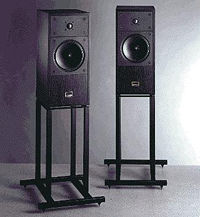Rewind to 1987 in Glasgow. Linn Products, which had earned its name with the Sondek LP12 turntable, was well aware that the new Compact Disc format was beginning to eat into its sales. The company’s response was to expand its loudspeaker lineup while also moving away from the first generation of boxes (Kan, Sara, and Isobarik) and toward a newer, more modern line…
Dr. Rod Crawford enters the picture. He was born in Tasmania, Australia, and went on to earn a first-class honors degree in Applied Science from Melbourne University, specializing in physics and metallurgy, as well as a Doctorate of Philosophy from Oxford University’s Department of Materials Science. After responding to a job advertising in a British hi-fi magazine, he found himself working for Linn four months later, inventing an improvement to the Sara loudspeaker, which was ultimately dubbed the Sara 9.
Rod was the project leader for the Nexus LS250 (the number representing the anticipated retail price), which was the first of Linn’s new series of speakers. Designed to compete directly with mid-price Mission boxes, it was also the first to use reflex loading, reputedly on Linn boss Ivor Tiefenbrun’s orders. This was a significant problem because all previous Linn speakers had used infinite baffle cabinets, which were chosen over ported boxes for their rapid, propulsive sound. To add to the intrigue, the Nexus was not only innovative, but it also had to be completed in a short period of time…
It took around four months to develop the speaker, which included a lot of late nights. A two-way design featuring a Japanese-sourced 203mm Tonegen mid/bass unit and a new 20mm tweeter was the result. Much listening was done during the development process, with a panel of people including Ivor, head of marketing Charlie Brennan, and two sales team members. It went through four changes in its first year, and during its four-year production cycle, it sold roughly 5,000 pairs every year. This was more than twice as many as Linn’s previous best-selling speaker, according to Rod Crawford.
The Nexus stands out from all prior Linn loudspeakers, which were all greatly influenced by the 1970s in terms of design. Although £250 was still a substantial sum when it was released in 1988, it is clearly built to a price. It may be hard to believe now, but on launch it looked ultra-modern with its grey painted front baffle, stretch-over grille and matching Ku-Stone stands which had been designed with the speakers rather than after them. The 255x540x290mm Nexus is huge for a standmounter by today’s standards, albeit it felt smaller at the time. It includes bi-wirable speaker connections on the back and weighs a heavy 25kg per box. The nominal impedance was stated to be 6 ohms, and the power handling was said to be 150W RMS, which was impressive back in the day. The Nexus wasn’t the world’s most sensitive speaker in the 1980s, but it was still significantly easier to drive than any of the preceding generation of Linn devices.
Despite the fact that the drive units and cabinets were significantly different, this speaker sounded very much like a Linn, which means tight, rapid, and punchy. Despite being reflex-ported, the Nexus captures the leading edges of notes with vigour, giving the music a strong sense of direction. It’s also dynamic, with the ability to communicate language well. The Nexus, on the other hand, isn’t the most tonally correct loudspeaker on the market. It’s been dubbed “grey and papery” by critics since it can’t accurately capture the entire flavour of acoustic instruments, for example. This is a critique that could be levelled against every Linn loudspeaker since the first generation, and even Dr Rod went on record later to explain that it was voiced in a specific way for a specific type of consumer, and was optimised for usage in a Linn system.
The Linn Nexus can now be found for under £150 on eBay, complete with matching Linn supports. If you appreciate the Linn sound, a well-preserved pair is still worth considering. It’s also a piece of history, since it marks the company’s shift into the modern era – at least in terms of loudspeakers. Rod Crawford is back in Australia, running Legend loudspeakers, after designing a complete line of Linn loudspeakers, including the Helix, Index 2, Tukan, Kaber, and Keltik.







